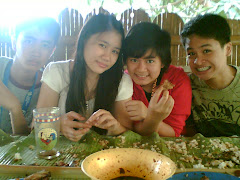Project in science...
GENETICS
Making a blog about biology is easy for me... but making a blog about genetics will be more difficult. Why? Because genetics is a very interesting topic. So interesting that even I can’t explain why? By the way ,asking me what did I really learn about genetics.. Here are some:
1ST- I now knew Gregor Johann Mendel!!
But, how did Gregor Johann Mendel change my life? Well, because of him I realize that every person came from the combination of the two haploid sex cells coming from my father and mother. Each combination will make different outputs. That is why I can never be exactly like my sister. I now know that mom and dad can make hundreds of person, though knowing that they are only the two of them. That is because each assortment can never happen again… isn’t that interesting?? Another is that, I really got amazed in finding out that he becomes aware of all those stuffs by just examining garden peas!! Wow!! Such a smart guy...
But why did Gregor Mendel, chose garden peas to be his model? That is because garden peas have constructing characteristics, have several generations over a short period of time, have short life span, and low maintenance! I can say that through him, a very intellectual person, we have learned and discovered the wonderful world of genetics!!
2ND- I have learned
I really don’t have anything to say about this topic but… I was just happy and proud to know this interesting matter, because it really blows me out!! ( o_O ) LOL...
3RD- Incomplete dominance, codominance, multiple alleles…
These topics are very exciting for me. It made me recognize that a cross of two species can make a whole knew heterozygous, having independent trait. Well I’m talking about incomplete dominance here. Another one is, I now distinguished that a cross between two organisms can result into a heterozygous having 50-50 appearance of the parents… that’s codominance! Multiple alleles may look difficult, but it is very easy. I had also recall my lessons about blood type, and had it understand them apparently!!
4TH- my real reflection
Explaining and writing everything I learned about genetics can took me weeks in typing in front of the computer. So to make it easy to me, I will just summarize it. First, I discovered a bunch of things about life. I learned about those heterozygous, homozygous dominant and recessive, the different traits… etc. I also comprehend about the different possibilities of a person having characteristics, though his/her parents doesn’t have any of those. This may be baldness, color-blindness and other traits that is not necessary for the a human-being. I also discovered different mutations such as changes in chromosomal structure and chromosome number, leading to monosomy or trisomy. These two words may direct in several diseases, like down syndrome, edward’s syndrome, patau’s syndrome, etc.. all in all, genetics is a long but wonderful topic!! It did’nt improved me. But, he made me a better person I didn’t thought5 I can be!!
OTHER RESEARCHES:
mutations are changes to the nucleotide sequence of the genetic material of an organism. Mutations can be caused by copying errors in the genetic material during cell division, by exposure to ultraviolet or ionizing radiation, chemical mutagens, or viruses, or can occur deliberately under cellular control during processes such as hypermutation. In multicellular organisms, mutations can be subdivided into germ line mutations, which can be passed on to descendants, and somatic mutations, which cannot be transmitted to descendants in animals. Plants sometimes can transmit somatic mutations to their descendants asexually or sexually (in case when flower buds develop in somatically mutated part of plant). A new mutation that was not inherited from either parent is called a de novo mutation.Mutations create variations in the gene pool, and the less favorable (or deleterious) mutations are reduced in frequency in the gene pool by natural selection, while more favorable (beneficial or advantageous) mutations tend to accumulate, resulting in evolutionary change. For example, a butterfly may produce offspring with a new mutation. Many times new mutations are harmful; a new mutation might change the color of one of the butterfly's offspring, making it harder (or easier) for predators to see. If this color change is an advantage, the chances of this butterfly surviving and producing its own offspring are a little better, and over time the number of butterflies with this mutation may form a larger percentage of the population.
Neutral mutations are defined as mutations whose effects do not influence the fitness of either the species or the individuals who make up the species. These can accumulate over time due to genetic drift. The overwhelming majority of mutations have no significant effect, since DNA repair is able to mend most changes before they become permanent mutations, and many organisms have mechanisms for eliminating otherwise permanently mutated somatic cells.










.jpg)






.jpg)

.jpg)

No comments:
Post a Comment